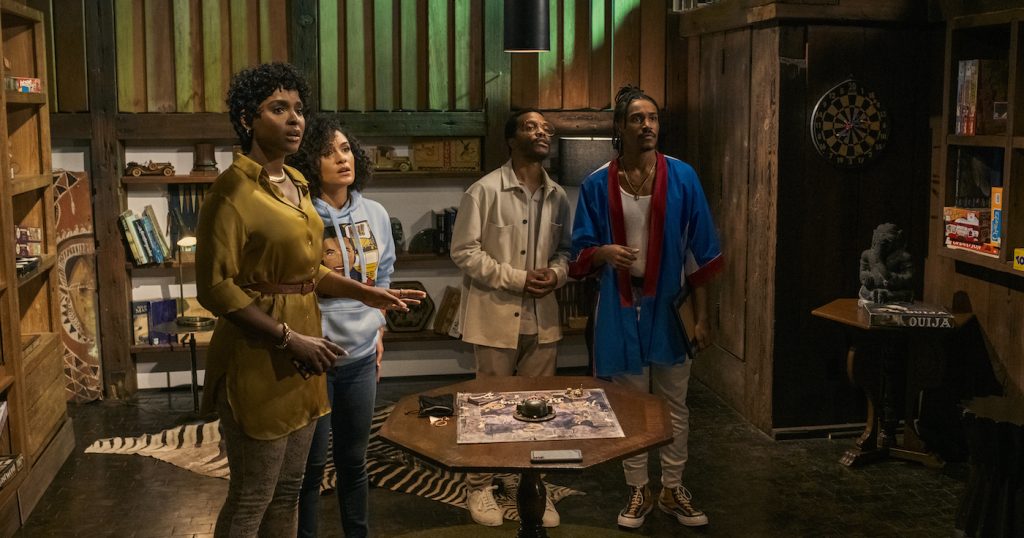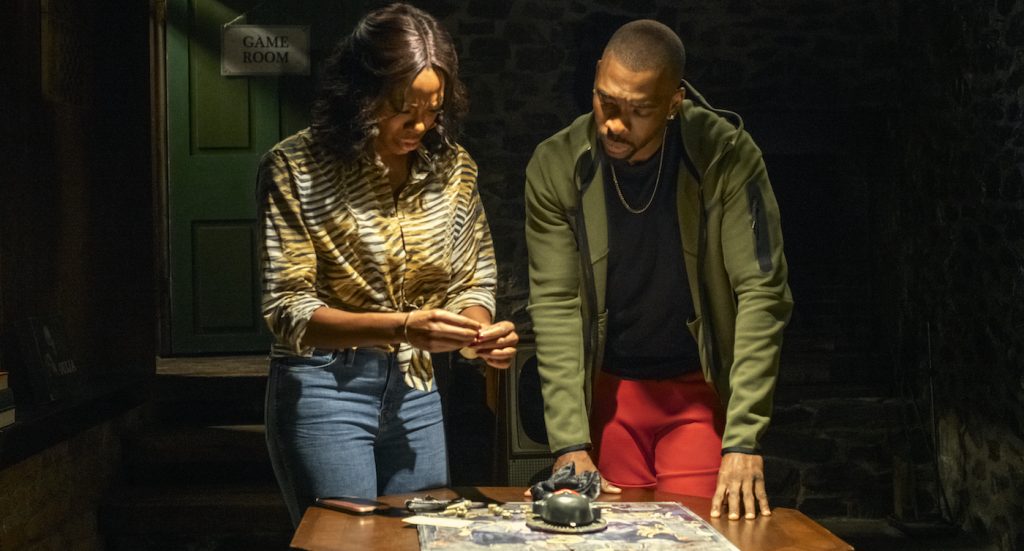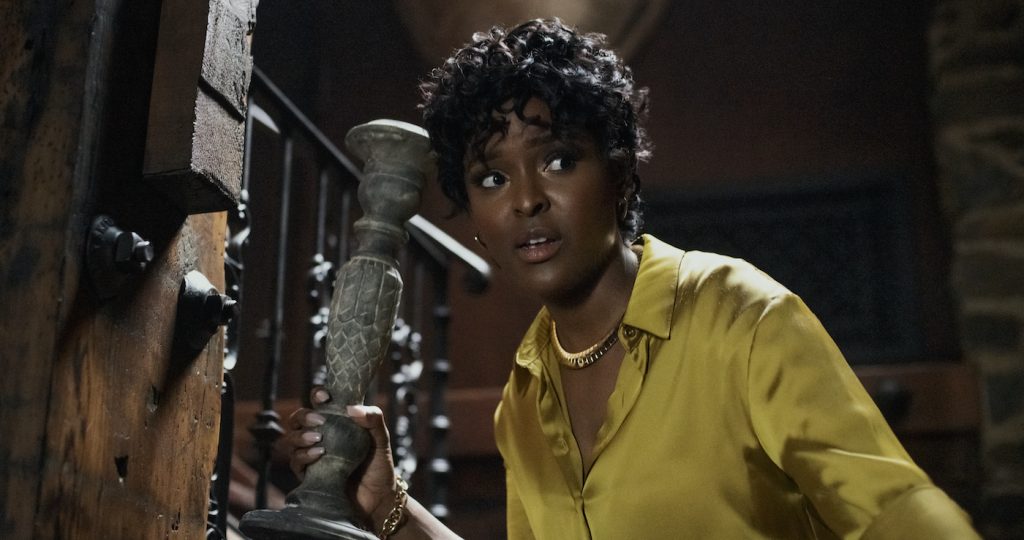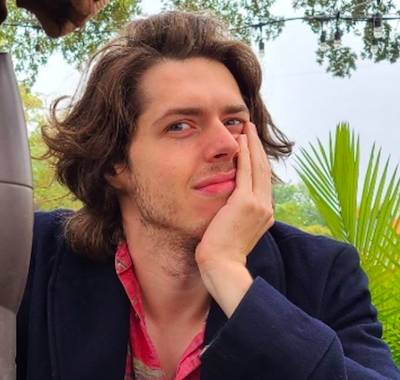“The Blackening” Cinematographer Todd A. Dos Reis on Lensing a Horror-Comedy Romp
It’s almost hard to believe The Blackening is cinematographer Todd A. Dos Reis’ first feature film. He’s been in the business for decades, having shot a variety of television shows, including Crazy Ex-Girlfriend, Bosch: Legacy, and Entourage. Before becoming a cinematographer for a long list of hit shows and music videos, he even worked on two Jean-Claude Van Damme classics, Hard Target and Double Impact, as an assistant cameraman.
The cinematographer’s career is full and varied, and it shows with the complete control of camera and tone in director Tim Story’s The Blackening. The horror-comedy brings a group of college friends together for a reunion in a cabin in the woods, where they’re terrorized by masked killers and a board game called The Blackening. The less said about the plot, the better—The Blackening is a film whose surprises you really want to enjoy without warning.
Recently, we could’ve spent days talking to Todd A. Dos Reis about his career but focused on his exceptional nighttime photography in The Blackening.
You made a contained space very cinematic with the game room, where the characters play the titular game. The colors really pop, especially green. How’d you want to create a mood in the house?
We had a very strange house in Brentwood that worked for most of it. It worked for everything except for the hallway and the basement scenes. I’m glad you picked up on the green because I really wanted to make that pop. There was a little more outside that didn’t make it into the final cut, but I like having green work for so many different things. I not only use it in this movie, but I use a lot of my television series for different reasons. But for this, it felt right just to have a weird element to be there. Whoever owned this house had some 30-year-old lighting fixture out in the backyard that they use for who knows what, hunting raccoons or something. I wanted to use it to play off of the cool colors. I use a lot of cool colors on the outside and on the inside of the house.

It always helps stretch the budget a little, right?
Since we had very little money, I had to use what they had there at the house. There was track lighting all around. When we needed another look, I basically just gelled what they already had up there and augmented it with a few of our movie lights. But in that game room, they spend a lot of time playing the game, and we had to make sure we created a look that wasn’t so bright and comedy-esque.
You and director Tim Story handle that tone well. It’s right up next to the line of horror parody, but it still falls within the horror-comedy genre. How’d you maintain that?
Tim and I talked about that. What we did is basically split up the duties. I knew he was a master at comedy, so he handled the comedy of it, and I wanted no part of the comedy as far as lighting goes. I lit it as a straight horror movie. I didn’t do anything you would see in a normal comedy, like a brighter light. I tried to keep it moody and shadowy and rich.

Was that game room a technical nightmare? You have a large cast, a tight space, and yes, they spend a lot of time there.
We could always go around the table because there was never a time when one character didn’t have something to say or a reaction shot or a reveal. Whether it be a three-shot or two-shot or singles, we just had to do it.
What’s it like working with and lighting an ensemble cast?
They’re all beautiful, and this range of skin tones was a challenge, but I knew if I had that exposure right in the middle, they’d all fall in. But I never really thought about how not to make them pretty or how to make them pretty because they were beautiful actors. I take the time to light the structure of their faces. These people were very easy to light. So that wasn’t a challenge [laughs].

You have some good nighttime photography in the movie with a lot of clarity. How’d you achieve that rare feat in a horror movie?
That was a challenge. We just always had to play that fine line between what’s too dark and what’s too bright. I tried to play the low end of it. We just make sure it’s not too dark for that one crazy theater in Silver Lake where the bulb is wearing out, and it’s gonna be really dark. So, how do we make sure that they see everything they need to see to make this a successful horror-comedy?
You actually have a really cool lens flare that helps you in a basement sequence.
Do you want me to tell you the trick?
Yes, please.
I’ve done a lot of music videos, so I’ve played with a lot of different toys and glass and flares. Over the decades of working, I would use this thing called a streak filter. [It was] made for when cinematographers or directors wanted to shoot spherical, but they wanted that anamorphic feel, but maybe you couldn’t afford anamorphic lenses. They’d put a streak filter on the camera and any kind of spotlight, like a headlight or a flashlight, and it gives you that streak. I’ve used it a lot in many series. If there’s a dream sequence, the streak filter’s coming out.
The Blackening is in theaters now.
For more on upcoming films and TV series, check out these stories:
Many of the Best Stunts in “Indiana Jones and the Dial of Destiny” Are Practical
“Stephen Curry: Underrated” Trailer Shows how an NBA Legend Was Made
Featured image: Melvin Gregg as King, Grace Byers as Allison, Antoinette Robertson as Lisa, Sinqua Walls as Nnamdi, Jermaine Fowler as Clifton, Dewayne Perkins as Dewayne, and Xochitl Mayo as Shanika in The Blackening. Photo Credit: Glen Wilson



